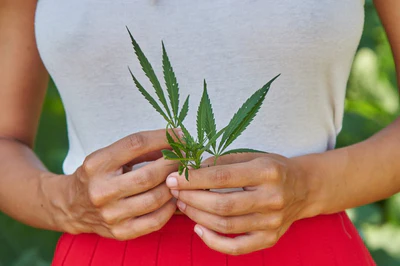Major Cannabinoids in Hemp and Marijuana
Cannabinoids are chemical compounds usually found in the Cannabis plant or made by the human (or animal) body in the endocannabinoid systems. There are two main types of cannabinoids: Endocannabinoids and Phytocannabinoids.
Endocannabinoids are made inside the body by the endocannabinoid system whereas phytocannabinoids are made by plants, namely Cannabis plants. There are also synthetic cannabinoids that are created in a lab and are able to be evaluated as prescription medications. Synthetic cannabinoids are often found to have more side effects, however.
Endocannabinoids:
There are two main endocannabinoids: Anandamide and 2-Arachidonylglycerol (2-AG). These are created by the endocannabinoid system in humans and other animals to maintain homeostasis or balance within the body.

Phytocannabinoids:
Phytocannabinoids are found almost exclusively in Cannabis plants, however there is at least one other plant (a type of liverwort) known to contain cannabinoids. For the purpose of this article, and in general, phytocannabinoids will simply be referred to as ‘cannabinoids.’ Some of the major cannabinoids and/or the main cannabinoids are CBD, Delta 9 THC, CBG, CBN, CBC, and Delta 8 THC. Not all of these are technically considered “major cannabinoids,” but they are currently the most prevalent in the cannabis industry. There are over 110 cannabinoids in the cannabis plant, most of which have medicinal properties and make other cannabinoids work better through something called the ‘Entourage Effect.’ The entourage effect is the idea that cannabinoids work better together than they do alone.

CBD:
CBD stands for Cannabidiol. This is the main cannabinoid in the hemp industry because it is somewhat the most concentrated cannabinoid in industrial hemp plants. I say ‘somewhat’ because CBDa or cannabidiolic acid is actually the most abundant cannabinoid in hemp plants for the most part. CBD comes from the breaking down of CBDa, a process known as decarboxylation. CBD is essentially the activated version of CBDa. CBD also has an abundance of health benefits and is not psychoactive which is really what has made it so popular. CBD has been studied for many potential health benefits including:
· May reduce inflammation
· May relieve pain
· May relieve stress
· May Reduce nausea
· May lower blood pressure
· may slow the proliferation of certain cancer cells
· Can reduce frequency and severity of seizures
· May support bone health
· May aid sleep
There are many more potential medicinal properties and benefits linked to CBD, but those are the main ones. CBD interacts with the endocannabinoid system and other bodily systems to provide those effects. Learn a little more about CBD here.
Delta 9 THC:
Delta 9 THC, short for Delta 9 Tetrahydrocannabinol, is the most common cannabinoid found in marijuana and is responsible for most of the intoxicating effects of marijuana. Delta 9 THC is often referred to as “THC.” Just like CBD comes from CBDa, Delta 9 THC comes from THCa (short for Delta 9 Tetrahydrocannabinolic acid). Delta 9 THC is very popular for its intoxicating psychoactive effects, but it also has a number of medicinal properties and benefits similar to CBD. Some of those properties and benefits include:
· May reduce inflammation
· May Reduce Pain
· May reduce anxiety
· May Relieve Nausea
· Stimulates appetite
· Anti-cancer – may kill certain cancer cells
· Anti-tumor – may shrink tumors and/or kill the cells responsible for the tumors
There are many more potential medicinal properties and benefits linked to Delta 9 THC, but those are some of the main ones. The intoxicating effects of THC set it aside from other cannabinoids and contribute to its recreational use. Delta 9 THC induces its psychoactive intoxicating effects mainly by binding to CB1 receptors in the endocannabinoid system. It also interacts with other endocannabinoid receptors and other systems throughout the body. Delta 9 THC is the most studied cannabinoid as it is the main one in marijuana. Learn more here.
CBG:
Another major hemp cannabinoid, CBG is short for cannabigerol. CBG, just like CBD and Delta 9 THC, comes from CBGa. CBGa (cannabigerolic acid) is actually the first cannabinoid to form and then breaks down into THCa, CBDa, CBCa, and more. CBG is known as the “Mother of all Cannabinoids” because of that. CBG is a non-psychoactive cannabinoid like CBD and most others. This is another popular cannabinoid because hemp plants can be grown to have high levels of CBG (really the plants are high in CBGa). Medicinally, CBG appears to have especially strong anti-inflammatory effects in the gut. This is because CBG binds well to the CB2 receptors of the endocannabinoid system which are mainly located in the gastrointestinal tract. CBG is a less studied cannabinoid and has not seen the same clinical trials that CBD and Delta 9 THC has, but it is clear that CBG has many medicinal properties and benefits including:
· May reduce inflammation (especially in the gut/gastrointestinal tract)
· May reduce pain
· Bone growth – may promote bone growth
· Anti-bacterial – CBG has shown in studies to kill bacteria, specifically MRSA (an antibiotic resistant bacteria)
· Anti-cancer – in test tube studies, CBG has been shown to kill colorectal cancer cells.
From user experience, ingesting CBG leads to a more uplifting feeling compared to CBD. CBG is a cannabinoid that is often used during the daytime to help improve focus and alertness while still offering a relaxing sensation, especially when smoked.
CBN:
CBN is short for cannabinol. Again, similar to the previous cannabinoids we discussed, CBN comes from CBNa or cannabinolic acid. However, CBNa does not come directly from CBGa like THCa, CBDa, and CBCa do. CBNa comes from the oxidation of THCa. CBNa then can be decarboxylated to become CBN. In marijuana, older batches will tend to have higher levels of CBN or CBNa as THCa oxidizes with time. CBN is considered slightly psychoactive as it does bind directly to the CB1 receptor. It is estimated that CBN has about 1/10 the binding strength that Delta 9 THC does for the CB1 Receptor. CBN is best known and mostly used as a sleep aid especially when combined with THC. While CBN is mainly used as a sleep aid, it has more potential medicinal properties and benefits including:
· May reduce inflammation
· May relieve pain
· May help to relax muscles
· May stimulate appetite
· May control psoriasis – CBN has shown to slow the overgrowth of skin cells
CBN is a very useful cannabinoid for a lot of people. Unfortunately its sedative effects are not felt by everyone. Some studies show that CBN is highly effective at inducing sleep, while others show no effect. It does seem that combining CBN with other cannabinoids like THC and CBC may induce greater sedative effects than having just one of those cannabinoids alone. This is another example of the entourage effect and how it is important to consider when using cannabis products.
CBC:
CBC is short for Cannabichromene. Like the previous cannabinoids we discussed, it comes from CBCa or cannabichromenic acid which comes from CBGa. CBC is another non-psychoactive cannabinoid. CBC is one of the newer cannabinoids becoming popular in the cannabis industry. Studies have found CBC to be promising for reducing stress. It has also shown promise for treating acne, pain, inflammation, and more. Perhaps the best effect of CBC is how it effects other cannabinoids. CBC has a strong entourage effect on other cannabinoids like THC’s, CBN, CBD, and more. CBC with CBN is a particularly important interaction as CBN’s sedative effects are not consistent from person to person. CBC can make CBN more effective even for people who experience no sedative effects from CBN alone. CBC’s medicinal properties and benefits include:
· May help relieve stress partly by increasing levels of anandamide in the body
· Anti-cancer – CBC increases the bodies levels of the endocannabinoid anandamide which has shown to kill certain cancer cells
· Acne inhibitor – CBC has shown to inhibit the production of lipids by sebaceous glands and reduce sebaceous gland inflammation.
CBC is a versatile cannabinoid that has many of its own effects as well as enhancing the effects of other cannabinoids. CBC often provides a very happy feeling when ingested.
Delta 8 THC:
Delta 8 THC is short for Delta 8 Tetrahydrocannabinol. Delta 8 THC forms a little bit differently than the other cannabinoids. While it is a naturally occurring compound, it occurs in very small amounts in the cannabis plant. As such, it is typically converted from CBD isolate into Delta 8 THC distillate through a process called isomerization. This process can be done in a natural way, using natural acids and enzymes to break down CBD into Delta 8 THC. Delta 8 THC can also be isomerized from delta 9 THC, which is more similar to how it naturally occurs, but in order to comply with the 2018 Farm Bill, it must be derived from hemp, and CBD is easier to get from hemp than Delta 9 THC is. Delta 8 THC is psychoactive and will induce intoxicating effects. It also has also been studied for a variety of potential medicinal effects including:
· Anti-emetic – may reduce nausea
· May relieve stress by inducing a feeling of relaxation
· May reduce inflammation
· May reduce pain
· Anti-cancer – may kill cancer cells and/or slow the proliferation of cancer cells
· May increase libido/sex drive
· May improve mood
· Neuroprotective – has shown in studies to protect memory cells
· Aid sleep
Delta 8 THC interacts with the same main receptors in the endocannabinoid system as Delta 9 THC does, so it has very similar effects both medicinally and recreationally.
Recreationally, it has the following effects from anecdotal evidence:
· Delta 8 THC is psychoactive and so it has recreational potential
· The high from Delta 8 THC is similar to Delta 9 THC except milder.
· Delta 8 THC is often described as a clear headed high.
· There is a definite body sensation and relaxation.
· Reportedly less mind fog than with Delta 9 THC
· Generally an uplifting high with a great sense of euphoria and lack of worry
· In smaller doses, the high can be good for day-time. Some people may benefit from increased creativity and a more outgoing personality when using Delta 8 THC.
· Most people consider it a fun, relaxing, and euphoric high without too much brain fog or confusion
Conclusion:
There are over 110 known cannabinoids in the cannabis plant, all of which have their own unique properties and generally all work synergistically. Some cannabinoids are geared more towards pain, some to sleep, some for fun, and more. Whether you are using cannabis medicinally or recreationally, it is helpful to understand the differences between cannabinoids and to not get too bogged down with just one cannabinoid. They work better together than they do alone and a lot of them tend to balance each other out. CBD and THC are just the tip of the iceberg when it comes to cannabis, and it is a really big iceberg. For more information on cannabis, click the link below.



